A Princess of Mars
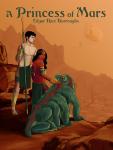
Author:Edgar Rice Burroughs
Tag:Edgar Rice BurroughsScience FantasyBarsoom SeriesAmerican
This book is a science fantasy novel by Edgar Rice Burroughs, the first of his Barsoom series. Full of swordplay and daring feats, the novel is considered a classic example of 20th century pulp fiction. It is also a seminal instance of the planetary romance, a sub-genre of science fantasy that became highly popular in the decades following its publication. Its early chapters also contain elements of the Western. The story is set on Mars, imagined as a dying planet with a harsh desert environment. This vision of Mars was based on the work of the astronomer Percival Lowell, whose ideas were widely popularized in the late 19th and early 20th centuries.
John Carter, a Confederate veteran of the American Civil War, goes prospecting in Arizona immediately after the war's end. Having struck a rich vein of gold, he runs afoul of the Apaches. While attempting to evade pursuit by hiding in a sacred cave, he is mysteriously transported to Mars, called "Barsoom" by its inhabitants. Carter finds that he has great strength and superhuman agility in this new environment as a result of its lesser gravity. He soon falls in with a nomadic tribe of Green Martians, or Tharks, as the planet's warlike, six-limbed, green-skinned inhabitants are known. Thanks to his strength and martial prowess, Carter rises to a high position in the tribe and earns the respect and eventually the friendship of Tars Tarkas, one of the Thark chiefs.
The Tharks subsequently capture Dejah Thoris, Princess of Helium, a member of the humanoid red Martian race. The red Martians inhabit a loose network of city-states and control the desert planet's canals, along which its agriculture is concentrated. Carter rescues Dejah Thoris from the green men in a bid to return her to her people.
Subsequently Carter becomes embroiled in the political affairs of both the red and green Martians in his efforts to safeguard Dejah Thoris, eventually leading a horde of Tharks against the city-state of Zodanga, the historic enemy of Helium. Winning Dejah Thoris' hand, he becomes Prince of Helium, and the two live happily together for nine years. However, the sudden breakdown of the Atmosphere Plant that sustains the planet's waning air supply endangers all life on Barsoom. In a desperate attempt to save the planet's inhabitants, Carter uses a secret telepathic code to enter the factory, bringing an engineer along who can restore its functionality. Carter then succumbs to asphyxiation, only to awaken back on Earth, left to wonder what has become of Barsoom and his beloved.
At the Earth's Core
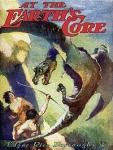
Author:Edgar Rice Burroughs
Tag:Edgar Rice BurroughsScience FantasyPellucidar seriesAmerican
This is a 1914 fantasy novel by Edgar Rice Burroughs, the first in his series about the fictional "hollow earth" land of Pellucidar.
The author relates how, traveling in the Sahara desert, he has encountered a remarkable vehicle and its pilot, David Innes, a man with a remarkable story to tell.
David is a mining heir who finances the experimental "iron mole," an excavating vehicle designed by his elderly inventor friend Abner Perry. In a test run, they discover the vehicle cannot be turned, and it burrows 500 miles into the Earth's crust, emerging into the unknown interior world of Pellucidar. In Burroughs' concept, the Earth is a hollow shell with Pellucidar as the internal surface of that shell.
Pellucidar is inhabited by prehistoric creatures of all geological eras, and dominated by the Mahars, a species of flying reptile both intelligent and civilized, but which enslaves and preys on the local stone-age humans. Innes and Perry are captured by the Mahars' ape-like Sagoth servants and taken with other human captives to the chief Mahar city of Phutra. Among their fellow captives are the brave Ghak, the Hairy One, from the country of Sari, the shifty Hooja the Sly One and the lovely Dian the Beautiful of Amoz.
David, attracted to Dian, defends her against the unwanted attentions of Hooja, but due to his ignorance of local customs she assumes he wants her as a slave, not a friend or lover, and subsequently snubs him. Only later, after Hooja slips their captors in a dark tunnel and forces Dian to leave with him, does David learn from Ghak the cause of the misunderstanding.
In Phutra the captives become slaves, and the two surface worlders learn more of Pellucidar and Mahar society. The Mahars are all female, reproducing parthogenetically by means of a closely guarded "Great Secret" contained in a Mahar book. David learns that they also feast on selected human captives in a secret ritual. In a disturbance, David manages to escape Phutra, becomes lost, and experiences a number of adventures before sneaking back into the city. Rejoining Abner, he finds the latter did not even realize he was gone, and the two discover that time in Pellucidar, in the absence of objective means to measure it, is a subjective thing, experienced by different people at different rates.
Obsessed with righting the wrong he has unwittingly done Dian, David escapes again and eventually finds and wins her by defeating the malevolent Jubal the Ugly One, another unwanted suitor. David makes amends, and he and Dian wed.
Later, along with Ghak and other allies, David and Abner lead a revolt of humankind against the Mahars. Their foes are hampered by the loss of the Great Secret, which David has stolen and hidden. To further the struggle David returns to the Iron Mole, in which he and Dian propose to travel back to the surface world to procure outer world technology. Only after it is underway does he discover that Hooja has substituted a drugged Mahar for Dian. The creature attacks David but is overcome, and the return to the surface world proceeds successfully.
Back in the world we know David meets the author, who after hearing his tale and seeing his prehistoric captive, helps him resupply and prepare the mole for the return to Pellucidar.
Jungle Tales of Tarzan
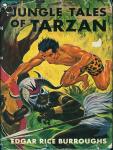
Author:Edgar Rice Burroughs
Tag:Edgar Rice BurroughsTarzanAmerican
This book is a collection of twelve loosely connected short stories written by Edgar Rice Burroughs, comprising the sixth book in order of publication in his series about the title character Tarzan. Chronologically it is a midquel to the first Tarzan novel, Tarzan of the Apes, as the events recounted in it actually occur within Chapter 11 of that novel, between Tarzan's avenging of his ape foster mother's death and his becoming leader of his ape tribe.
Tarzan's First Love
Tarzan's courtship of the female ape Teeka ends in failure when her preference turns to their mutual friend, the male ape Taug. Tarzan wrestles with his humanness versus his ape-ness.
The Capture of Tarzan
Tarzan is taken captive by the warriors of a village of cannibals which has established a village near the territory of the ape tribe. He is saved from them by Tantor, the elephant.
The Fight for the Balu
Teeka and Taug have a baby (balu, in the ape language), which Teeka names Gazan and will not allow Tarzan near. She changes her mind after Tarzan saves the baby from a leopard.
The God of Tarzan
Tarzan discovers the concept of "God" in the books preserved in the cabin of his dead parents, to which he pays regular visits. He inquires among members of his ape tribe for further elucidation without success, and continues his investigation among the cannibals of the nearby village and the natural phenomena of his world, such as the sun and moon. Eventually he concludes that God is none of these, but the creative force permeating everything. Somehow, though, the dreaded snake Histah falls outside this.
Tarzan and the Black Boy
Jealous of Taug and Teeka's relationship with their baby, Tarzan kidnaps Tibo, a little boy from the neighboring village to be his own "balu." He tries with indifferent success to teach the terrified and homesick child ape ways. Meanwhile, Momaya, Tibo's mother does everything she can think of to find and recover her son, even visiting the hermit witch-doctor Bukawai, a terrible, diseased exile who keeps two fearsome hyenas as pets. He names a price for recovering Tibo she cannot afford, and she leaves disappointed. Afterwards, however, Tarzan, who is moved by Tibo's distress and his mother's love, returns the boy to her.
The Witch-Doctor Seeks Vengeance
Bukawai attempts to claim credit for Tibo's return and extort payment from the boy's mother, but is rebuffed. He plots vengeance against the native family and Tarzan, but is thwarted by the ape man.
The End of Bukawai
Bukawai, finding Tarzan unconscious after a storm, takes the ape man captive and stakes him out for his hyenas to devour. Escaping, Tarzan leaves the witch doctor in the same trap, in which Bukawai suffers the very fate he had intended for his enemy.
The Lion
Tarzan vainly attempts to impress on his ape tribe the necessity of maintaining a strict watch against the hazards and perils surrounding them. To drive home the lesson, he dons a lionskin he has taken from Mbonga's village and suddenly appears among them, only to find them more vigilant than he had thought, as they mob him and nearly beat him to death. He is saved only by the courage of his monkey friend Manu, which he had also previously under-rated, who risks all to reveal to Teeka and Taug that the "lion" is actually Tarzan.
The Nightmare
Having been unsuccessful hunting, Tarzan robs the native village of some rotten elephant meat, which he eats. Becoming ill from the tainted meal, he has a horrible nightmare, in which he dreams himself menaced by a lion, an eagle, and huge snake with the head of a village native. He is carried off by a giant bird but wakes in the fall from its graps, finding himself back in the tree where he'd gone to sleep. He realizes the incidents were not real. Subsequently attacked by a gorilla, he assumes that this too is a product of his fevered imagination, until actually wounded and hurt. He kills the beast, but is left to wonder what is real and what is fantasy. The only thing he is certain of is that he will never again eat the meat of an elephant.
The Battle for Teeka
Discovering bullet cartridges in his deceased father's cabin, Tarzan takes them with him as curios. Subsequently, Teeka is taken by an ape from another tribe, and Tarzan and Taug join forces to trail the kidnapper and rescue her. When they catch up, they are surrounded by the enemy tribe and nearly overwhelmed, until Teeka throws the cartridges at their foes in an apparently futile effort to help. When some of them hit a rock, they explode, frightening the hostile apes and saving her "rescuers."
A Jungle Joke
As part of his campaign of torment and trickery against the native village, whose members he holds responsible for his ape foster mother's death, Tarzan captures Rabba Kega, the local witch doctor, and puts him in a trap the natives have set to catch a lion. The next day the warriors find they have caught the lion, but it has killed the witch doctor. They take the lion to the village. Tarzan secretly releases it and appears among them dressed in the lionskin he had previously used to trick the apes. Dropping the disguise, he reveals himself and leaves. When the natives muster enough courage, they follow, only to encounter the real lion, which they assume is Tarzan in his disguise again. They are quickly disabused.
Tarzan Rescues the Moon
Tarzan frees a native warrior the apes have caught on being impressed by the man's bravery, angering the rest of the ape tribe. Alienated, he exiles himself to his parents' cabin. Later, frightened by an eclipse in which darkness appears to devour the moon, they summon him back. Tarzan reassures them by shooting arrows at the "devourer," and as the eclipse passes is given credit by the creatures for the "rescue."
Out of Time's Abyss
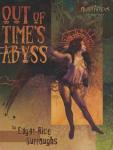
Author:Edgar Rice Burroughs
Tag:Edgar Rice BurroughsCaspak trilogyAmerican
This book is an Edgar Rice Burroughs fantasy-science fiction novel, the third of his Caspak trilogy.
The book begins with Bradley, who had left Fort Dinosaur on an expedition in the first novel and never returned. Bradley and his party are attempting to return to Fort Dinosaur. Along the way, they encounter a creature which appears to be a flying dead man. Some of the members of the party consider it to be a ghost or banshee. Tippet is convinced that he is soon to die, and the next day he is killed by a Tyrannosaurus. The ghost-like creature is seen again, and James is killed by a saber-toothed cat. Bradley disappears during the night, and the remaining members of the party make it safely to Fort Dinosaur.
Bradley had been captured by the ghost-like creature, which is soon revealed to be a naturally winged human being, belonging to a subgroup of humanity known as the Wieroo. The Wieroo takes Bradley to the island of Oo-oh, set in Caspak's inland sea. It attempts to keep Bradley in a prison, but he escapes through a secret passage. He meets Co-Tan, a member of the highest human race of mainland Caspak, the Galu, fully human and of a neolithic cultural level. They enter the chamber of the Wieroo king, a huge member of the race, and Bradley kills the creature with its own sword.
Co-Tan and Bradley escape the city of the Wieroo and live for several months on the forested coast of Oo-oh. Finally, though, they are discovered by Wieroo. They succeed in capturing two of the Wieroo and forcing them to fly to the mainland, one bearing each of the humans.
On the Caspakian mainland, Co-Tan and Bradley meet the party from the outside world from the previous two books, and they return home to America, where Bradley will marry Co-Tan.
Pellucidar
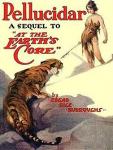
Author:Edgar Rice Burroughs
Tag:Edgar Rice BurroughsScience FantasyPellucidar seriesAmerican
This book is a 1915 fantasy novel by Edgar Rice Burroughs, the second in his series about the fictional "hollow earth" land of Pellucidar.
David Innes and his captive, a member of the reptilian Mahar master race of the interior world of Pellucidar, return from the surface world in the Iron Mole invented by his friend and companion in adventure Abner Perry.
Emerging in Pellucidar at an unknown location, David frees his captive. He names the place Greenwich and uses the technology he has brought to begin the systematic exploration and mapping of the unknown land while searching for his lost companions, Abner, Ghak, and Dian the Beautiful. He soon encounters and befriends a new ally, Ja the Mezop of the island country of Anoroc; later he finds Abner, from whom he learns that in his absence the human revolt against the Mahars has not been going well.
In a parlay with the Mahars David bargains for information of his love Dian and his enemy Hooja the Sly One, which his foes agree to supply in return for the book containing the Great Secret of Mahar reproduction that David stole and hid in the previous novel. David undertakes to recover it, only to find that Hooja has been there before him and claimed Dian as his own reward of the Mahars!
Now he has to track down and defeat the sly one before resuming the human war of independence. Ultimately this is accomplished, and with the aid of the resources David has brought from the surface world he and Abner succeed in building a confederacy of human tribes into an "Empire of Pellucidar" that wipes out the Mahar cities and establishes a new human civilization in their place.
Tarzan and the Jewels of Opar
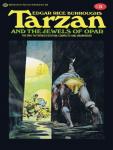
Author:Edgar Rice Burroughs
Tag:Edgar Rice BurroughsTarzanAmerican
This book is a novel written by Edgar Rice Burroughs, the fifth in his series of books about the title character Tarzan.
In the previous novel Tarzan and Jane's son, Jack Clayton, a.k.a. Korak, had come into his own. In this novel Tarzan returns to Opar, the source of the gold where a lost colony of fabled Atlantis is located, in order to make good on some financial reverses he has recently suffered. While Atlantis itself sank beneath the waves thousands of years ago, the workers of Opar continued to mine all of the gold, which means there is a rather huge stockpile but which is now lost to the memory of the Oparians and only Tarzan knows its secret location.
A greedy, outlawed Belgian army officer, Albert Werper, in the employ of a criminal Arab, secretly follows Tarzan to Opar. There, John Clayton loses his memory after being struck on the head by a falling rock in the treasure room during an earthquake. On encountering La, the high priestess who is the servant of the Flaming God of Opar, and who is also very beautiful, Tarzan once again rejects her love which enrages her and she tries to have Tarzan killed; she had fallen in love with the apeman during their first encounter and La and her high priests are not going to allow Tarzan to escape their sacrificial knives this time.
In the meanwhile, Jane has been kidnapped by the Arab and wonders what is keeping her husband from once again coming to her rescue. A now amnesiac Tarzan and the Werper escape from Opar, bearing away the sacrificial knife of Opar which La and some retainers set out to recover. There is intrigue and counter intrigue the rest of the way.
Tarzan of the Apes
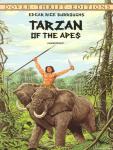
Author:Edgar Rice Burroughs
Tag:Edgar Rice BurroughsTarzanAmerican
Tarzan of the Apes is a novel written by Edgar Rice Burroughs, the first in a series of books about the title character Tarzan.
The novel tells the story of John Clayton, born in the western coastal jungles of equatorial Africa to a marooned couple from England, John and Alice (Rutherford) Clayton, Lord and Lady Greystoke. Adopted as an infant by the she-ape Kala after his parents died (his father is killed by the savage king ape Kerchak), Clayton is named "Tarzan" ("White Skin" in the ape language) and raised in ignorance of his human heritage.
Feeling alienated from his peers due to their physical differences, he discovers his true parents' cabin, where he first learns of others like himself in their books, with which he eventually teaches himself to read.
On his return from one visit to the cabin, he is attacked by a huge gorilla which he manages to kill with his father's knife, although he is terribly wounded in the struggle. As he grows up, Tarzan becomes a skilled hunter, gradually arousing the jealousy of Kerchak, the ape leader.
Later, an African tribe settles in the area, and Kala is killed by one of its hunters. Avenging himself on the killer, Tarzan begins an antagonistic relationship with the tribe, raiding its village for weapons and practicing cruel pranks on them. They, in turn, regard him as an evil spirit and attempt to placate him.
The twelve short stories Burroughs wrote later and collected as Jungle Tales of Tarzan occur in the period immediately following the arrival of the natives, the killing of Kala, and Tarzan's vengeance.
Finally Tarzan has amassed so much credit among the apes of the tribe that the envious Kerchak at last attacks him. In the ensuing battle Tarzan kills Kerchak and takes his place as "king" of the apes.
Subsequently, a new party of whites is marooned on the coast, including Jane Porter, the first white woman Tarzan has ever seen. Tarzan's cousin, William Cecil Clayton, unwitting usurper of the ape man's ancestral English estate, is also among the party. Tarzan spies on the newcomers, aids them, and saves Jane from the perils of the jungle. Absent when they are rescued, he is introduced further into the mysteries of civilization by French Naval Officer Paul D'Arnot, whom he saves from the natives. D'Arnot teaches Tarzan French and how to behave among white men, as well as serving as his guide to the nearest colonial outposts.
Ultimately, Tarzan travels to Jane's native Baltimore, Maryland only to find that she is now in the woods of Wisconsin. Tarzan finally meets Jane in Wisconsin where they renew their acquaintance and he learns the bitter news that she has become engaged to William Clayton. Meanwhile, clues from his parents' cabin have enabled D'Arnot to prove Tarzan's true identity. Instead of claiming his inheritance, Tarzan chooses to conceal his identity and renounce his heritage for the sake of Jane's happiness.
Tarzan the Untamed
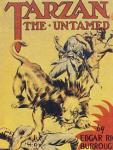
Author:Edgar Rice Burroughs
Tag:Edgar Rice BurroughsTarzanAmerican
This book is a book written by Edgar Rice Burroughs, the seventh in his series of books about the title character Tarzan.
The action is set during World War I. While John Clayton, Lord Greystoke (Tarzan) is away from his plantation home in British East Africa, it is destroyed by invading German troops from Tanganyika. On his return he discovers among many burned bodies one that appears to be the corpse of his wife, Jane Porter Clayton. Another fatality is the Waziri warrior Wasimbu, left crucified by the Germans. (Wasimbu's father Muviro, first mentioned in this story, goes on to play a prominent role in later Tarzan novels.)
Maddened, the ape-man seeks revenge not only on the perpetrators of the tragedy but all Germans, and sets out for the battle front of the war in east Africa. On the way he has a run-in with a lion (or Numa, as it is called by the apes among whom Tarzan was raised), which he traps in a gulch by blocking the entrance. At the front he infiltrates the German headquarters and seizes Major Schneider, the officer he believes led the raid on his estate. Returning to the gulch, he throws his captive to the lion. Tarzan goes on to help the British in the battle in various ways, including setting the lion loose in the enemy trenches, and kills von Goss, another German officer involved in the attack on the Greystoke estate.
He then becomes embroiled in the affairs of Bertha Kircher, a woman he has seen in both the German and British camps, and believes to be a German spy, particularly after he learns she possesses his mother's locket, which he had given as a gift to Jane. His efforts to retrieve it lead him to a rendezvous between Kircher and Captain Fritz Schneider, brother of the major Tarzan threw to the lion previously, and the actual commander of the force that burned the estate. Killing Schneider, Tarzan believes his vengeance complete. Abandoning his vendetta against the Germans he departs for the jungle, swearing off all company with mankind.
Seeking a band of Mangani, the apes among whom he had been raised, Tarzan crosses a desert, undergoing great privations. Indeed, the desert is almost his undoing. He only survives by feigning death to lure a vulture (Ska in the ape language) following him into his reach; he then catches and devours the vulture, which gives him the strength to go on. The scene is a powerful one, a highlight both of the novel and of the Tarzan series as a whole.
On the other side of the desert Tarzan locates the ape band. While with them he once again encounters Bertha Kircher, who has just escaped from Sergeant Usanga, leader a troop of native deserters from the German army, by whom she had been taken captive. Despite his suspicion of Bertha, Tarzan's natural chivalry leads him to grant her shelter and protection among the apes. Later he himself falls captive to the tribe of cannibals the deserters have sheltered among, along with Harold Percy Smith-Oldwick, a British aviator who has been forced down in the jungle. Learning of Tarzan's plight, Bertha heroically leads the apes against the natives and frees them both.
Smith-Oldwick becomes infatuated with Bertha, and they search for his downed plane. They find it, but are captured again by Usanga, who attempts to fly off in it with Bertha. Tarzan arrives in time to board the plane as it takes off and throw Usanga from the plane. Smith-Oldwick and Bertha Kircher then try to pilot it back across the desert to civilization, but fail to make it. Seeing the plane go down, Tarzan once more sets out to rescue them. On the way he encounters another Numa, this one an unusual black lion caught in a pit trap, and frees it.
He, the two lovers and the lion are soon reunited, but attacked by warriors from the lost city of Xuja, hidden in a secret desert valley. Tarzan is left for dead and Bertha and Smith-Oldwick taken prisoner. The Xujans are masters of the local lions and worshippers of parrots and monkeys. They are also completely insane as a consequence of long inbreeding. Recovering, Tarzan once more comes to the rescue of his companions, aided by the lion he had saved earlier. But the Xujans pursue them and they turn at bay to make one last stand. The day is saved by a search party from Smith-Oldwick's unit, who turn the tide.
Afterward, Tarzan and Smith-Oldwick find out that Bertha is a double agent who has actually been working for the British. Tarzan also learns from the diary of the deceased Fritz Schneider that Jane might still be alive.
The Beasts of Tarzan
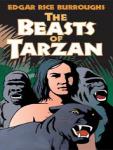
Author:Edgar Rice Burroughs
Tag:Edgar Rice BurroughsTarzanAmerican
This book is a novel written by Edgar Rice Burroughs, the third in his series of books about the title character Tarzan.
Not long after Tarzan claims his hereditary title of Lord Greystoke and marries Jane, their infant son, Jack, is kidnapped in London by his old Russian enemies, Nikolas Rokoff and Alexis Paulvitch. Following an anonymous call about the whereabouts of Jack, Tarzan himself falls into Rokoff's trap and is imprisoned aboard a ship carrying Jack. Jane, fearing Tarzan was entering a trap, follows him and also finds herself in Rokoff's clutches aboard the ship. Rokoff sets sail to Africa, eventually exiling Tarzan on an island near the African coast and telling Tarzan that Jack will be left with a cannibal tribe and raised as one of their own.
Using his jungle skill and primal intelligence, Tarzan wins the help of Sheeta, the vicious panther, a tribe of great apes led by the intelligent Akut, and the native warrior Mugambi. With their aid, Tarzan reaches the mainland, kills Rokoff, and tracks down his wife and son. Paulvitch, the other villain, is presumed dead, but manages to escape into the jungle.
The Chessmen of Mars
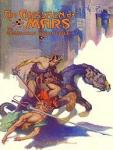
Author:Edgar Rice Burroughs
Tag:Edgar Rice BurroughsScience FantasyBarsoom SeriesAmerican
This is an Edgar Rice Burroughs science fantasy novel, the fifth of his famous Barsoom series.
In this novel Burroughs focuses on a younger member of the family established by John Carter and Dejah Thoris, protagonists of the first three books in the series. The heroine this time is their daughter Tara, princess of Helium, whose hand is sought by the gallant Gahan, Jed (prince) of Gathol. Both Helium and Gathol are prominent Barsoomian city states.
Tara meets Prince Gahan of Gathol, and is initially unimpressed, viewing him as something of a popinjay. Later she takes her flier into a storm and loses control of the craft, and the storm carries her to an unfamiliar region of Barsoom. After landing and fleeing from a pack of ferocious Banths (Martian lions), she is captured by the horrific Kaldanes, who resemble large heads with small, crab-like legs. The Kaldanes have bred a symbiotic race of headless human-like creatures called Rykors, which they can attach themselves to and ride like a horse. While imprisoned, Tara manages to win over one of the Kaldanes, Ghek, with her lovely singing voice.
Gahan, who has fallen in love with Tara, sets out to find her, only to find himself caught up in the same storm, and he falls overboard while attempting to rescue one of his crew. He stumbles upon Bantoom, realm of the Kaldanes, and manages to rescue Tara, and together with Ghek they flee in Tara's crippled flier. Tara doesn't recognize Gahan as the prince she met earlier, as he is worn from his ordeals and no longer dressed in his fancy clothes. In light of her earlier reaction to him, Gahan decides to keep his identity secret, and identifies himself instead as a Panthan (warrior) called Turan.
The three of them manage to reach the isolated city of Manator. Gahan ventures into the city seeking food and water, but is tricked and taken prisoner by the inhabitants. Tara and Ghek are also captured. In Manator, captives are forced to a fight to the death in the arena, in a modified version of Jetan, a popular Barsoomian board game resembling Chess; the living version uses people as the game pieces on a life-sized board, with each taking of a piece being a duel to the death.
The Gods of Mars
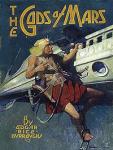
Author:Edgar Rice Burroughs
Tag:Edgar Rice BurroughsScience FantasyBarsoom SeriesAmerican
This book is a 1918 Edgar Rice Burroughs science fantasy novel, the second of his famous Barsoom series.
At the end of the first book, A Princess of Mars, John Carter is unwillingly transported back to Earth. The Gods of Mars begins with his arrival back on Barsoom (Mars) after a ten-year separation from his wife Dejah Thoris, his unborn child, and the Red Martian people of the nation of Helium, whom he has adopted as his own. Unfortunately, Carter materializes in the one place on Barsoom from which nobody is allowed to depart: the Valley Dor, which is the Barsoomian afterlife.
After John Carter's arrival, a boat of Green Martians on the River Iss are ambushed by the previously unknown Plant Men. The lone survivor is his friend Tars Tarkas, the Jeddak of Thark, who has taken the pilgrimage to the Valley Dor to find Carter. Having saved their own lives, Carter and Tars Tarkas discover that the Therns, a white-skinned race of self-proclaimed gods, have for eons deceived the Barsoomians elsewhere by disseminating that the pilgrimage to the Valley Dor is a journey to paradise. Most arrivals are killed by the beasts of Valley, and the survivors enslaved by Therns.
Carter and Tars Tarkas rescue Thuvia, a slave girl, and attempt to escape, capitalizing on the confusion caused by an attack by the Black Pirates of Barsoom upon the Therns. During the attack, Tars Tarkas and Thuvia hijack a Black Pirate flier, while Carter fights his way aboard another, killing all but one of the Pirates, and rescuing a captive Thern princess. From the captured Pirate Xodar, Carter learns that the Black Pirates, called the "First Born", also think of themselves as gods, and accordingly prey upon the Therns; and additionally identifies the captive Thern as Phaidor, daughter of the "Holy Hekkador" (high priest) of the Therns. When their flier is recaptured by the First Born and taken to their realm of Omean, Carter is taken before Issus, the self-proclaimed goddess of Barsoom, who dictates the Therns through secret communications which they mistake for divine revelation.
Issus takes Phaidor as a handmaiden for one Martian year; whereas Carter is imprisoned, with Xodar as his slave as punishment for being defeated by Carter. Thereafter Carter treats him with honor, and thus gains his friendship. In prison, they encounter a young man later identified as Carter's son Carthoris, with whom Carter is taken to a series of games wherein the previous year's handmaidens are eaten by Issus and her nobles. Carter leads a revolt of the prisoners, killing many of the First Born; and upon the suppression of their revolt, he and Carthoris escape via underground tunnels, and give themselves to guards unacquainted with the revolt to be returned to their prison. Upon hearing of the revolt, Xodar rejects Issus’ divinity and joins the others in escape. Upon later abandoning their aircraft, they encounter Thuvia, who describes the capture of Tars Tarkas by the green warriors of Warhoon (a clan rival to his own). Carter goes to rescue Tars Tarkas, but is discovered by his enemies. After a chase, Thuvia is sent on alone mounted while the men attempt a stand against the Warhoons. They are rescued by the Heliumetic navy but do not find Thuvia. Commanding one of the warships is Carter’s friend Kantos Kan but the fleet is commanded by Zat Arras, a Jed (chieftain) of the hostile client state of Zodanga, and Carter is suspected of returning from Valley Dor, which is punishable by death. Tardos Mors, the Jeddak of Helium, and Mors Kajak, the Jed of Hastor (the grandfather and father, respectively, of Dejah Thoris, and thus Carter’s in-laws) are absent from Helium, having led fleets in search of Carthoris. Later, Carter discovers that Dejah Thoris may have taken the pilgrimage to the Valley Dor to find him.
Upon returning to Helium, Carter is tried for heresy by the Zodangans; but the people of Helium do not tolerate this, and Carter is held prisoner for 365 days until his son frees him. Thereafter he goes to rescue Dejah Thoris but is kidnapped by the Zodangans. Carter refuses Zat Arras’ offer of freedom in exchange for endorsing Zat Arras as Jeddak of Helium, and is imprisoned. After half a (Barsoomian) year, Carter escapes, and embarks to Omean, with secretly raised troop levies, ships, and soldiers lent by Tars Tarkas. Near Omean Carter is challenged first by the Therns; secondly by Zat Arras; and lastly by the First Born, whereupon Carter causes the Therns and First Born to fight one another, and the Heliumetic crews of the Zodangan fleet mutiny in support of Carter. Thereafter the Heliumites and Tharks defeat the First Born, and Issus herself is killed. But Dejah Thoris, Thuvia, and Phaidor are imprisoned in the Temple of the Sun, of whose rooms each opens only once per year. Immediately before their room closes, Phaidor attempts to kill Dejah Thoris, and her success or failure are left unknown. The story is thence continued in the third book of Burroughs’ Martian series, The Warlord of Mars.
The Land That Time Forgot
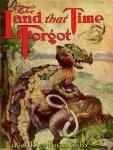
Author:Edgar Rice Burroughs
Tag:Edgar Rice BurroughsCaspak trilogyAmerican
This is an Edgar Rice Burroughs fantasy novel, the first of his Caspak trilogy. His working title for the story was "The Lost U-Boat." The sequence was first published in Blue Book Magazine as a three-part serial in the issues for September, October and November 1918. The complete trilogy was later combined for publication in book form under the title of the first part by A. C. McClurg in June 1924. Beginning with the Ace Books editions of the 1960s, the three segments have usually been issued as separate short novels. The first of these is treated in this article.
The novel is set in World War I and opens with a framing story in which a manuscript relating the main story is recovered from a thermos off the coast of Greenland. It purports to be the narrative of Bowen J. Tyler, an American passenger with his Airedale terrier Nobs on a ship sunk in the English Channel by a German U-boat, U-33, in 1916. He is rescued by a British tugboat with another survivor, Lys La Rue. The tug is also sunk, but its crew manages to capture the submarine when it surfaces. Unfortunately, all other British craft continue to regard the sub as an enemy, and they are unable to bring it to port. Sabotage to the navigation equipment sends the U-33 astray into the South Atlantic. The imprisoned German crew retakes the sub and begins a raiding cruise, only to be overcome again by the British. A saboteur continues to guide the sub off course, and by the time he is found out it is in Antarctic waters.
The U-33 is now low on fuel, with its provisions poisoned by the saboteur Benson. A large island ringed by cliffs is encountered, and identified as Caprona, a land mass first reported by the (fictitious) Italian explorer Caproni in 1721 whose location was subsequently lost. A freshwater current guides the sub to a stream issuing from a subterranean passage, which is entered on the hope of replenishing the water supply. The U-boat surfaces into a tropical river teeming with primitive creatures extinct elsewhere; attacked, it submerges again and travels upstream in search of a safe harbor. It enters a thermal inland sea, essentially a huge crater lake, whose heat sustains Caprona’s tropical climate. As the sub travels north along the island’s waterways the climate moderates and wildlife undergoes an apparent evolutionary progression.
On the shore of the lake the crew builds a palisaded base, dubbed Fort Dinosaur for the area’s prehistoric fauna. The British and Germans agree to work together under Tyler, with Bradley, the mate from the tug, as second in command and Von Schoenvorts, the original sub commander, in control of the Germans. The castaways are attacked by a horde of beast men and take prisoner Ahm, a Neanderthal. They learn that the native name for the island is Caspak. Oil is discovered, which they hope to refine into fuel for the U-33. As they set up operations, Bradley undertakes various explorations. During his absence Lys disappears and the Germans mutiny again, absconding with the submarine.
Tyler leaves the other survivors to seek and rescue Lys. A series of adventures ensues among various bands of near-human primitives, each representing a different stage of human advancement, as represented by their weaponry. Tyler rescues Lys from a group of Sto-lu (hatchet men), and later aids the escape of a woman of the Band-lu (spearmen) to the Kro-lu (bowmen). Lys is lost again, and chance discoveries of the graves of two men associated with Bradley’s expedition leaves Tyler in despair of that party’s fate. Unable to find his way back to Fort Dinosaur, he retreats to the barrier cliffs ringing Caspak in a vain hope of attracting rescue from some passing ship. Improbably reunited with Lys, he sets up house with her, completes the account of his adventures which he has been writing, and casts it out to sea in his thermos.
The Lost Continent
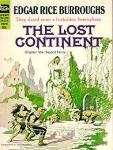
Author:Edgar Rice Burroughs
Tag:Edgar Rice BurroughsScience FictionAmerican
The Lost Continent is one of the least-known of Burroughs' thrilling science-fiction tales. In the year 2137, civilization has been in decline for nearly two centuries, and war-torn Europe is but a distant memory to the inhabitants of the isolated United States. But an American adventurer rediscovers the Old World, which has become a strange and savage land.
The Monster Men
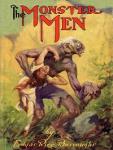
Author:Edgar Rice Burroughs
Tag:Edgar Rice BurroughsScience FictionAmerican
This book is a science fiction novel written by Edgar Rice Burroughs in 1913 under the working title "Number Thirteen."
Cornell University professor Arthur Maxon, who has been experimenting in the creation of artificial life, travels with his daughter Virginia to one of the remote Pamarung Islands in the East Indies to pursue his project. Their departure is noted with interest by a young man, Townsend J. Harper, Jr., who is quite taken with Virginia and determines to find out where they are going. In Singapore Maxon commissions Dr. Carl von Horn to take them the remainder of the way to their destination in his yacht the Ithaca, and then to assist him in his experiments. On the island the group fights off a pirate attack and builds a fort.
Maxon and von Horn begin their experiments, growing several living creatures in chemical vats, humanoid but mindless and ugly. Maxon hopes Experiment Number Thirteen will result in a perfect human being, and in his fanatic obsession plans to wed Virginia to this ultimate creation. Von Horn retains a more realistic viewpoint and hopes to marry her himself, leading to friction. Meanwhile, locals including Budadreen, one of von Horn’s crewmen, and Muda Saffir, leader of the pirates, conspire against the scientists, who they believe are hiding treasure. They are watched closely by Chinese cook Sing Lee, who recognizes the pirate.
Experiment Number Thirteen indeed appears to result in a physically perfect man, but as soon as the scientists discover this an emergency distracts them. Experiment Number One has escaped and abducted Virginia. Maxon, von Horn and Sing Lee pursue the monster, only to find it dead at the hands of Number Thirteen, also escaped from the lab in the wake of the scientists’ departure. Thinking Virginia still in danger, von Horn attacks the creature and is nearly killed himself, but is spared by Thirteen when Virginia pleads for his life. Ignorant of the handsome stranger’s origin, the girl finds herself attracted to him.
Maxon and von Horn return Thirteen to the lab and begin educating him. Von Horn privately discloses to Virginia Maxon's plan to wed her to one of his creatures, while concealing it is her rescuer to whom she is to be wed. Separately, he informs Thirteen of his artificial origin. Both recipients of his confidences are horrified. Thirteen, or Jack, as he is now called, is convinced that he is a soulless monster and that Maxon must be stopped.
Von Horn absconds with Virginia while Jack goes to confront Maxon, while Budadreen and six crewmen steal a chest they believe holds Maxon’s wealth. Muda Saffir’s pirates attack the compound and appropriate the chest. Jack, reconsidering his rage, defends Maxon and Sing Lee against the pirates. Virginia rebuff’s von Horn’s advances and falls in with Budadreen, who takes her captive and sails off in von Horn’s yacht. Von Horn, since his effort to turn Jack against Maxon has failed, releases the other eleven monsters against them. Jack overawes the creatures and gains control of them, but Maxon, apparently regaining his sanity, turns on him and drives him away.
The Ithaca is wrecked in a gale, and Budadreen and his men swept overboard; later the drifting hulk is boarded by headhunters. Jack and the eleven monsters search for Virginia and find the yacht in the harbor, when it is boarded by Muda Saffir's pirates, the monsters attack them. Saffir takes Virginia and flees the battle in his prahu; the monsters, capturing another prahu, pursue them.
Having witnessed these events from hiding, von Horn returns to Maxon, who offers him his fortune and Virginia if he can save her. Jack and his monsters overtake and fight the pirates in Borneo, resulting in six monsters and many of the pirates killed, but Saffir, still holding Virginia, escapes up river in his boat. The monsters join with Barunda and a crew of captive Dyaks and resume pursuit. Meanwhile Saffir has bungled a rape attempt against Virginia and been shoved overboard by her; his lieutenant Ninaka assumes command. He stops at a native village, hides the chest and Virginia, and when Jack arrives conspires with Barunda to have the natives lead him astray. He then recovers his contraband and continues up river; Virginia ultimately escapes by diving off the boat.
Meanwhile Von Horn, Maxon and Sing Lee sail to Borneo, encounter the Ithaca, and enlist the Dyaks to take them to Muda Saffir. The latter, having survived his dip in the drink, flags them down. He and von Horn make a secret deal and continue up river without Maxon, who is stricken with fever. Jack's band, lost, encounters an orangutan band after fighting off more Dyaks. Finding one of them has captured Virginia, they fight the apes. Von Horn, Muda Saffir and a group of native warriors happen on the battle and spirit off the unconscious Virginia; Sing Lee, following, sees all. Von Horn's group and Sing Lee go back to Maxon, who is recovering. Von Horn presses his suit with Virginia.
Ninaka and Barunda fall out; Barunda is murdered, but this drives Ninaka ashore. Ninaka buries the chest lest it encumber his escape. Von Horn and a couple Dyaks, returned from delivering Virginia to her father, witness this. Afterwards von Horn kills his companions to keep the secret of the treasure to himself and flees back down river, narrowly missing Muda Saffir heading the other way with two war prahus; Saffir has again abducted Virginia. She escapes again and falls in with Jack and his surviving monsters; spotted by the pirates, they flee, one of the monsters dying to cover the retreat while Jack carries Virginia to safety. Making his stand in a small canyon, he casts boulders down on their pursuers until they retreat. He promises the girl he will take her back to her father, but soon after is stricken with a fever. She tends him in his delirium.
Maxon, von Horn, and Sing Lee search for Virginia, and come across the two just as Jack's fever breaks. Von Horn shoots Jack, but Sing Lee disarms him, stopping him from finishing him off. Von Horn finally reveals to Virginia that Jack is Number Thirteen, but she decides she loves Jack regardless. Then Sing Lee declares Jack is not a monster after all, but an amnesiac he had found drifting in a lifeboat and substituted for Maxon's failed experiment. He then exposes the crimes of von Horn, who flees into the jungle. An American naval vessel arrives; it turns out to be seeking von Horn, a deserter, to arrest him. The pursuit finally ends at the site of the buried "treasure," which von Horn has dug up; his headless body is found next to the opened chest. It had contained books, not treasure, and von Horn's native accomplices were evidently upset.
The Maxons and Jack leave Borneo on the navy ship, and Jack's memory returns. He is conveniently revealed as Townsend Harper, the wealthy (and single) young man who took an interest in Virginia at the beginning of the book. Wedding bells are plainly not far off.
The Outlaw of Torn
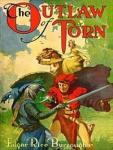
Author:Edgar Rice Burroughs
Tag:Edgar Rice BurroughsHistorical NovelsAmerican
The story is set in 13th century England and concerns the fictitious outlaw Norman of Torn, who purportedly harried the country during the power struggle between King Henry III and Simon de Montfort. Norman is the supposed son of the Frenchman de Vac, once the king's fencing master, who has a grudge against his former employer and raises the boy to be a simple, brutal killing machine with a hatred of all things English. His intentions are partially subverted by a priest who befriends Norman and teaches him his letters and chivalry towards women.
Otherwise, all goes according to plan. By 17, Norman is the best swordsman in all of England; by the age of 18, he has a large bounty on his head, and by the age of 19, he leads the largest band of thieves in all of England. None can catch or best him. In his hatred for the king he even becomes involved in the civil war, which turns the tide in favor of de Montfort. In another guise, that of Roger de Conde, he becomes involved with de Montfort's daughter Bertrade, defending her against her and her father's enemies. She notes in him a curious resemblance to the king's son and heir Prince Edward.
Finally brought to bay in a confrontation with both King Henry and de Montfort, Norman is brought down by the treachery of de Vac, who appears to kill him, though at the cost of his own life. As de Vac dies, he reveals that Norman is in fact Richard, long-lost son of King Henry and Queen Eleanor and brother to Prince Edward. The fencing master had kidnapped the prince as a child to serve as the vehicle of his vengeance against the king. Luckily, Norman/Richard turns out not to be truly dead, surviving to be reconciled to his true father and attain the hand of Bertrade.